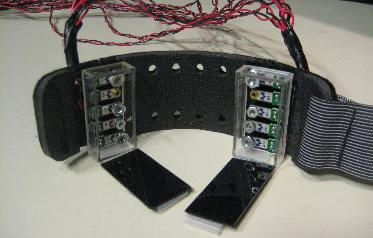Fact be told, there is no better way to describe how amazing this new product is, then by watching their video demo...
http://www.xbox.com/en-US/live/projectnatal/BUT...

Project Natal is a new product that's about to come out by the end of this year (to be honest, that's what they said last year and I'm not sure they're on schedule for this year too...).
It is a new way to control your home game console (Xbox 360 only) without any remote control, or in another words, with you as a remote control.
As Spielberg described it "a technology that recognizes not only your thumbs and your wrists, but your entire being".
What he refers to by that is not only your entire body.
Microsoft also made a very impressive voice recognition system to work with that product as well.
The video recognition system they built not only recognizes movements on the screen, it is capable to analyze your body and to distinguish between hands and legs, and can recognize your face in comparison to other people on the screen and tell them apart and give them different avatar on the screen.
All of that is done by a very advanced face and body recognition software, 2 small cameras to be able to get 3d movement around the room and a special sensor that is able to map the room.
The software itself functions with a standard gesture control, that recognizes specific movements and translates them to software functions.

Does this look like a new and awesome technology?

And how about this game?
Unfortunately for Microsoft, the second image is from a game almost ten years old, made by sony for PS2 with EyeToy.
EyeToy is another product with video recognition ability.
True, it is not as sophisticated as what Microsoft is working on, but MS are obviously not the pioneers in that field.
In fact, ever since webcams became commercial, in 1991, games using motion sensors started popping up. for example bouncing a ball on the screen, or wiping a screen from "dirt".
So Microsoft are doing the same (and still genius) trick, of taking several technologies already created, and combining them together into one awesome product. (that's how MS-DOS and the first Windows came out, and the feature of multi-tasking).
I have several future predictions, for the near and far future.
First thing, it is true that the controller is limiting our control over the game console.
but, as the thumbs bother us to go above and beyond our imagination, our body also does none the less. especially for people who are not in shape and have absolutely no aspiration for it (which makes too much of earths population\gamer population to me).
As we speak,
Emotiv is working on the development of a mind reader controller that works with brain waves.

As the progress of this company goes, it seems the product is still far from fully functional (but it definitely looks cool!!).
And for the even more distant future -

Holodeck!
not very original, I know, and very star-trek geeky of me to post that picture, but it still makes me wonder how it would be to get into a dark room, and to command it to start, and then suddenly I'm in the desert with sand at my feet.
looking around I see nothing but sand, the warm sun camels with their owners wondering around in the distance ----- and the metallic door from which I came in from... :)
Cheers,
DP





